
The body of Robert Francis Bailey
Robert Francis Bailey
At 5:19am on September 13, 1967 emergency services were called when a concerned citizen walking to work noticed a bright light coming from inside an abandoned home at 49 Auckland Street in Lambeth, South London. When the fire department arrived at 5:24am they discovered the burning body of Robert Francis Bailey, a local homeless alcoholic. One of the responding firefighters reported, “When we entered the building he [Robert Francis Baily] was lying on the bottom of the stairs half-turned on his left side and his knees were drawn up as though he was trying to bend the pain from his stomach”. Baily had been conscious as he burned to death and there was evidence to suggest he had been convulsing in agony as the fire consumed him. He had bitten into the post on the stairs which was made of solid mahogany and his teeth were embedded so deeply into the wood that his mouth had to be pried open by the fire department in order to remove his body. The firefighter described what he had witnessed, “There was about a four inch slit in his stomach and the flame was emanating from that four inch slit like a blow torch. It was a blue flame. The flame was actually coming from the body itself. From inside the body. He was burning literally from the inside out. And it was definitely under preassure. And it was impinging on the timber flooring below the body, so much so that the heat from the flame was charred into the woodwork.”. The only fire damage in the house was on the floor, directly below where the body had been burning. Aside from the abdomen where the fire had originated, Robert Francis Bailey’s clothes were intact and unaffected by the fire. The fire department put out the flames almost immediately, originally believing Bailey may still have been alive; The job required the use of several fire extinguishers and was incredibly difficult. Robert Francis Bailey’s original cause of death was determined to be “asphyxia due to inhalation of fire fumes” but after reviewing the case further his death was deemed to have been due to “unknown causes”.
Michael Faherty

The home of Michael Faherty
Seventy-six year old MichaelFaherty was found dead in his home in Clareview Park, Ballybane, Galway, Ireland on December 22, 2010 after his neighbor, Mr.Mannion was awoken by a fire alarm and noticed smoke coming from Faherty’s house. The official cause of death for Michael Faherty was “spontaneous combustion.”. Quite frankly, of all claims of SHC I find it very odd that this is the one investigators chose to officially name as a real case of spontaneous human combustion.
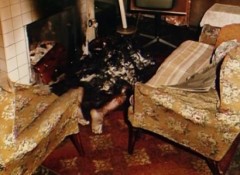
The body of Michael Faherty
While no accelerants were found and the fire that consumed Mr. Faherty had only damaged the floor directly beneath and the ceiling directly above the body, he was found with his head next to an open and active fireplace. A lead official working on the case stated, “The fire was thoroughly investigated and I’m left with the conclusion that this fits into the category of spontaneous human combustion for which there is no adequate explanation.”.
Dr. John Irving Bentley
From 1925-1953 John Irving Bentley had worked as a family physician in Coudersport, Pennsylvania. He had suffered a fractured hip in 1947 which affected his mobility and had caused him to be infirm in his senior years. Dr. Bentley remained in Coudersport where he was friendly with many residents which he had served as physician to before his retirement. On December 4, 1966, ninety-two year old John Irving Bentley received visitors who left at around 9pm that evening.

The home of Dr. John Irving Bentley
The following morning, Don Gosnell, meter reader with the North Penn Gas Company arrived at Dr. Bentley’s two-story home on Main Street and let himself in, as usual due to the ninety-two year old’s immobility. When he entered the house, Don Gosnell noticed a light blue smoke and a strange smell which was “somewhat sweet, like starting up a new oil-burning system.”. After going into the basement to read the meter he saw there was a pile of ash on the floor. Concerned about the strange conditions in which he found the home, he set off to search for Dr. Bentley. Don Gosnell found the upstairs bedroom filled with smoke and in the bathroom he discovered the doctor’s remains.
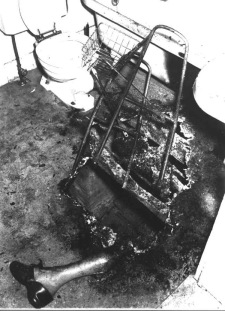
The body of Dr. John Irving Bentley
All that was left of John Irving Bentley was the lower half of his right leg, still wearing a slipper and his walker on top of a 2 1/2 by 4 foot hole burned into the floor. Dr. Bentley’s ashes had fallen through this hole and into the basement. Terrified, Don Gosnell ran back to the gas company screaming, “Doctor Bentley’s burned up!” and coworkers later said, “He [Don Gosnell] looked as white as a sheet.”. Aside from the hole burned into the floor, there were few signs of fire damage. The nearby tub was nearly unscathed and the rubber tips on Dr. Bentley’s walker were intact. Found inside the bathtub was Dr. Bentley’s burned robe and in the toilet were the remnants of “what was apparently a water pitcher.”. The official cause of death was recorded as “death by asphyxiation and 90 percent burning of the body”. It is theorized that Dr. Bentley had set fire to himself in his bedroom with his pipe and went into the bathroom in an attempt to extinguish the flames, becoming unconscious before he could do so. While this theory is plausible considering Dr. Bentley was an avid pipe smoker and his robe showed signs of multiple previous accidents with hot ash, his pipe was found sitting neatly in its stand by his bedside as though it had not been used anytime recently. The fire which consumed Dr. Bentley is estimated to have burned at 2,500 degrees Fahrenheit, a common element of supposed cases of spontaneous human combustion.
Helen Conway
On the evening of November 7, 1964 Helen Conway was babysitting the two children of her daughter and son-in-law overnight at her home in Upper Darby, Pennsylvania. The following morning at 8:42am Helen Conway’s granddaughter, Stephanie delivered a book of matches to her invalid grandmother upstairs upon request. Very shortly thereafter, Helen Conway’s neighbor who was leaving for church noticed an odd glow coming from inside the upstairs window of 527 Argyll Road and came to the house to investigate. The heat was so intense she was unable to make it upstairs and called the fire department. As firefighters searched the smoke-filled room at 8:48am one of them stuck his hand “into something greasy” which tuned out to be the remains of Helen Conway.
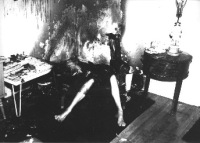
The body of Helen Conway
All that was left of her were her legs from the knee-down. Her lower legs and feet were unburnt but blistered. Two blisters broke on her leg during examination; they were wet but did not leak fluid. This is a clear indication that the 51-year-old widow was alive as she burned. Her left arm, which had burned down to the bone still had a bracelet eerily dangling from it. The only major signs of fire damage was on the chair Helen Conway sat in as she burned to death. 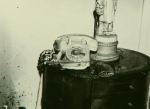 A telephone sitting on a nearby table had begun to melt but a pack of cigarettes on the same table were not affected. Sheets on the bed in the adjoining bedroom were spotless but the television set sitting on a dresser had melted while a highly flammable doll sitting next to the TV was nearly untouched.
A telephone sitting on a nearby table had begun to melt but a pack of cigarettes on the same table were not affected. Sheets on the bed in the adjoining bedroom were spotless but the television set sitting on a dresser had melted while a highly flammable doll sitting next to the TV was nearly untouched.  Helen Conway was a very heavy smoker and was a bit careless with her cigarettes. Multiple cigarette burns were found on furniture in her bedroom. One theory suggests Helen Conway lit herself on fire while smoking. As the chair she sat in became progressively charred the top broke off and fell backwards, taking the upper portion of Helen Conway’s body with it. Investigators believed “The Wick Effect” was the cause of her death. The Wick Effect is a commonly use to explain potential spontaneous human combustion. Under this theory, the human body is basically an inside out candle with clothing acting as the wick and human fat as the ignition. While it has been proven to be an explanation for some believed cases of SHC, it takes seven hours to destroy a human body. Obviously, this explanation would be highly feasible if it weren’t for one teeny tiny little detail… The fire that consumed the majority of Helen Conway’s body and burned at 2,500 degrees Fahrenheit began and ended in six minutes. No accelerants were used; Her death was originally considered to be foul play due to the rate and intensity at which the fire burned.
Helen Conway was a very heavy smoker and was a bit careless with her cigarettes. Multiple cigarette burns were found on furniture in her bedroom. One theory suggests Helen Conway lit herself on fire while smoking. As the chair she sat in became progressively charred the top broke off and fell backwards, taking the upper portion of Helen Conway’s body with it. Investigators believed “The Wick Effect” was the cause of her death. The Wick Effect is a commonly use to explain potential spontaneous human combustion. Under this theory, the human body is basically an inside out candle with clothing acting as the wick and human fat as the ignition. While it has been proven to be an explanation for some believed cases of SHC, it takes seven hours to destroy a human body. Obviously, this explanation would be highly feasible if it weren’t for one teeny tiny little detail… The fire that consumed the majority of Helen Conway’s body and burned at 2,500 degrees Fahrenheit began and ended in six minutes. No accelerants were used; Her death was originally considered to be foul play due to the rate and intensity at which the fire burned.
Mary Reeser
Around 8am on July 2, 1951 Pansy Carpenter went to deliver a telegram and a cup of coffee to her tenant Mary Reeser. After discovering the doorknob to her home was burning hot, Pansy asked for the help of two painters working nearby to assist in opening the door. When they finally entered, the three were met with a gust of hot air. The home showed some signs of fire but Mrs. Reeser was nowhere to be found. There was a bit of a bit of smoke and a small fire still burning on a beam which separated the bedroom from the kitchenette. Emergency services were called and discovered the body of Mary Reeser. All that remained of her was her left foot still wearing a black satin slipper, a charred liver fused to a fragment of vertebrae and a shrunken skull which was approximately the size of a teacup.
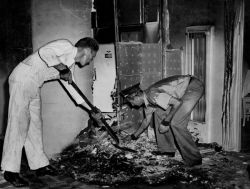
The remains of Mary Reeser
The 170lb. woman had been reduced to a pile of remains weighing less that 10lbs. Dr. Wilton Krogman, the leading American forensic expert on the subject of death by fire at that time was called in to study the case. In 25 years of working in his field, Dr. Krogman was baffled by the shrunken skull. In deaths by burning, the skull expands from the heat and literally explodes. While it is not uncommon for the skull to shrink in claims of SHC (one of many elements that makes these cases so intriguing), it is absolutely unheard of in any burning deaths outside of these rare phenomena. The chair Mary Reeser was sitting in at the time of her death had been burned until all that was left of it was some coils from its interior but a nearby pile of newspapers was untouched by the fire. A mirror on the wall had cracked due to the intense heat and many appliances in the home had melted; Otherwise, the home was generally unaffected by the fire which is estimated to have burned at 3,000 degrees Fahrenheit. Local investigators in St. Petersburg, Florida were so stumped by the case that Police Chief J.R. Reichert sent a box of evidence to J. Edgar Hoover containing glass fragments found in the ashes, a section of carpet, the unburnt shoe from Mrs. Reeser’s remaining foot and six “small objects thought to be teeth” along with a note which read, “We request any information or theories that could explain how a human body could be so destroyed and the fire confined to such a small area and so little damage done to the structure of the building and furniture in the room not even scorched or damaged by smoke.”. The case of Mary Reeser was so astounding J. Edgar Hoover even discussed the case with President Harry S. Truman before replying to the St. Petersburg Police. On August 8, the FBI ruled Mary Reeser’s death to have been due to “The Wick Effect” saying that Mrs. Reeser had taken her regular dose of sleeping pills and fell asleep while smoking a cigarette in her armchair. 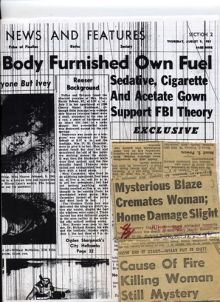 They claimed the rayon nightgown, robe and bedroom slippers she was last seen alive in the previous evening by her son and a neighbor acted as a wick and her body fat kept the fire going until she had been completely consumed. Those who worked on the case up-close-and-personal strongly disagreed with the FBI’s explanation. Experts asserted there is no way a fire started by a cigarette could create a blaze of that intensity. Dr. Wilton Krogman vehemently protested the FBI’s theory and said throughout his life that the case, particularly the shrunken skull, haunted him. As previously mentioned, the Wick Effect takes seven hours to consume a body. While there is no way to know for sure when the fire that killed Mary Reeser began, we get a pretty good idea from a clock in the room which stopped at 2:26am, presumably due to the heat from the fire. Pansy Carpenter, Mrs. Reeser’s landlady said she awoke that morning to the smell of smoke at around 5:00am. She believed it to be caused by the water pump in the garage overheating again. She got up, turned it off, and returned to bed. If the fire began shortly before 2:26am and raged on until just before Pansy Carpenter entered Mrs. Reeser’s apartment, that would be approximately seven hours; However, the FBI’s theory doesn’t quite add up. If Mary Reeser took sleeping pills on a regular basis, one would assume she took them quite a bit earlier in the evening.
They claimed the rayon nightgown, robe and bedroom slippers she was last seen alive in the previous evening by her son and a neighbor acted as a wick and her body fat kept the fire going until she had been completely consumed. Those who worked on the case up-close-and-personal strongly disagreed with the FBI’s explanation. Experts asserted there is no way a fire started by a cigarette could create a blaze of that intensity. Dr. Wilton Krogman vehemently protested the FBI’s theory and said throughout his life that the case, particularly the shrunken skull, haunted him. As previously mentioned, the Wick Effect takes seven hours to consume a body. While there is no way to know for sure when the fire that killed Mary Reeser began, we get a pretty good idea from a clock in the room which stopped at 2:26am, presumably due to the heat from the fire. Pansy Carpenter, Mrs. Reeser’s landlady said she awoke that morning to the smell of smoke at around 5:00am. She believed it to be caused by the water pump in the garage overheating again. She got up, turned it off, and returned to bed. If the fire began shortly before 2:26am and raged on until just before Pansy Carpenter entered Mrs. Reeser’s apartment, that would be approximately seven hours; However, the FBI’s theory doesn’t quite add up. If Mary Reeser took sleeping pills on a regular basis, one would assume she took them quite a bit earlier in the evening.
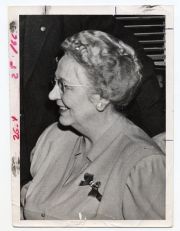
Mary Reeser
Remember, this was a 67-year-old woman in 1951 whose landlady delivered coffee to at 8am. Unfortunately, there are no records of what time Mrs. Reeser’s son and neighbor left her home that evening, but the details given by Pansy Carpenter imply that Mary Reeser was up and out of bed by 8am every morning. For that to be possible when using medication to sleep, Mrs. Reeser would have to take her pills by midnight each evening, no later. If she had, in fact, taken the pills at her usual time and fallen asleep while smoking it would mean the ember which supposedly fell into her clothes remained inactive for about two hours before starting a fire which grew to 3,000 degrees Fahrenheit. Some put the time of the clock stopping between 4:00am and 4:20am (we’re going with 2:26 because that time is cited in books and I trust books more that the internet) and if that is the case, there certainly would not have been enough time for Mary Reeser’s body to be destroyed to the point it was by way of the Wick Effect. More bizarrely, why would J. Edgar Hoover consult the President on the matter, not simply inform him of it. All these little details that don’t quite make sense in addition to the fact that no one working on the case outside of the FBI agreed with the Wick Effect theory in the case of Mary Reeser makes it one of the most intriguing examples of SHC to this day. One theory considered in an attempt to “logically” explain her death was that Mary Reeser was murdered… using cremation equipment; However, that theory was let go when it left no explanation for the melted appliances.
Check out the NEW BOOK by The Post-Mortem Post’s Head Writer ‘Horrible History: Mass Suicides’ AVAILABLE NOW on Amazon Kindle!
If you love The Post-Mortem Post, please consider supporting us on Patreon.com!
Follow us on Twitter @PostMortem_post and Like The Post-Mortem Post on Facebook
If you enjoyed this article, you might also like A Witness to Spontaneous Combustion and Other Stories of SHC, Evidence Suggests Spontaneous Human Combustion is a Reality, Scientists Have Answered the Question ‘If a Tree Falls in the Forest Does it Make a Sound?‘, Evidence Suggests Sixth Sense in Humans, Pray the Decay Away: Incorruptible Corpses and Other Forms of Natural Post Mortem Preservation, Everybody Poops: The Postmortem Edition, The Zombie Cat Parasite, THE WALKING DEAD: Indonesia and Is Kicking the Bucket for Catholics Only?








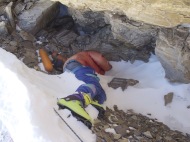


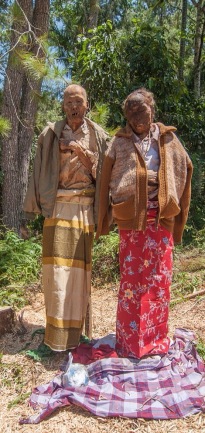



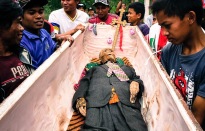









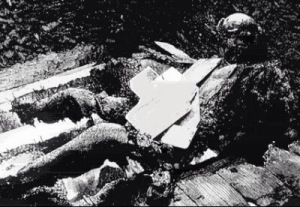
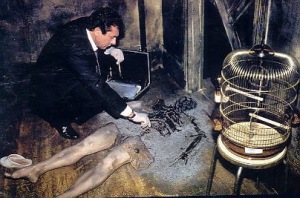













 This caused quite a bit of uproar from residents of Chihuahua who weren’t too thrilled knowing they would be walking past the corpse of a young woman on a regular basis. Eventually, most citizens became used to Pascualita staring at them through the window as they strolled around downtown. Som revel in the presence of this local oddity and view her as a sort of landmark which brings in a flock of tourists from Europe, South America and the United States each year. This story however, may be entirely, or at least partially legend. Many older residents of the area swear the body is truly that of the deceased Pascualita Esparza but just as many claim that shortly after the town went into an uproar over her display in the window, Pascuala made a statement that the body was not her deceased daughter. Obviously, the most logical theory is that Pascualita is a very life-like mannequin that was incredibly impressive for the time period; Perhaps Pascuala started an itty bitty rumor in an attempt to draw in customers to the store. One thing which keeps people questioning the authenticity of Pascualita is the small, lifelike and possibly decomposition related-imperfections such as the deep folds of her palm.
This caused quite a bit of uproar from residents of Chihuahua who weren’t too thrilled knowing they would be walking past the corpse of a young woman on a regular basis. Eventually, most citizens became used to Pascualita staring at them through the window as they strolled around downtown. Som revel in the presence of this local oddity and view her as a sort of landmark which brings in a flock of tourists from Europe, South America and the United States each year. This story however, may be entirely, or at least partially legend. Many older residents of the area swear the body is truly that of the deceased Pascualita Esparza but just as many claim that shortly after the town went into an uproar over her display in the window, Pascuala made a statement that the body was not her deceased daughter. Obviously, the most logical theory is that Pascualita is a very life-like mannequin that was incredibly impressive for the time period; Perhaps Pascuala started an itty bitty rumor in an attempt to draw in customers to the store. One thing which keeps people questioning the authenticity of Pascualita is the small, lifelike and possibly decomposition related-imperfections such as the deep folds of her palm.


